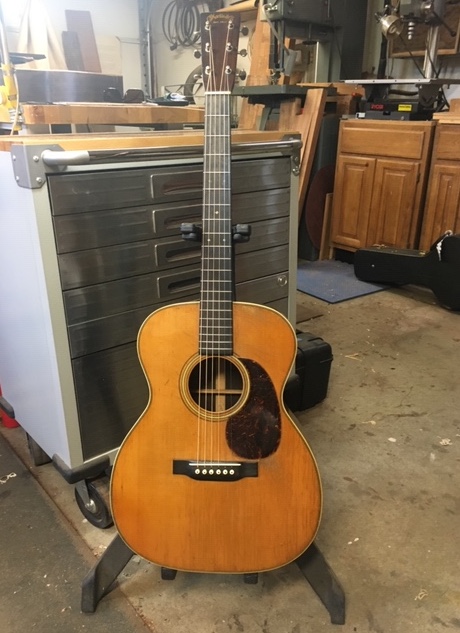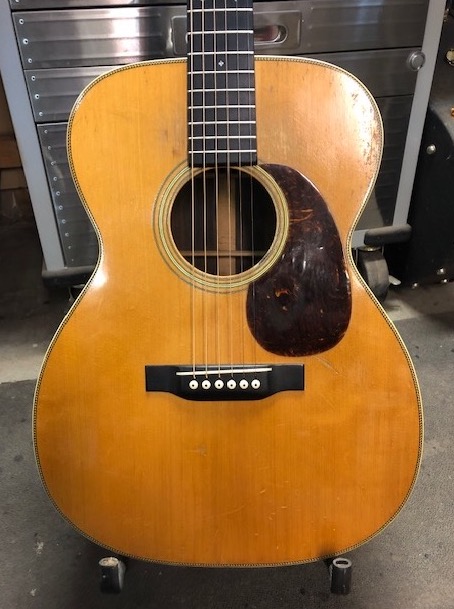For the next installment in our ongoing series delving into the history of iconic guitar models, we spoke with Marty Lanham, owner of Nashville Guitar Company and an instructor at Guitar Craft Academy Nashville, about the CF Martin OM.
Could you talk about the history of the CF Martin OM acoustic guitar?
The “OM” stands for “orchestra model.” I think it’s a really interesting piece, a really important part of their history. It was first built in 1929, and it was a response to changes in popular music and the demands of musicians of the day. Previously, up until the 1920s, dance bands used a four-string banjo for the rhythm section, and that was starting to change to the sound of guitar, which was more versatile. Guitars at the time only had 12 frets out from the body, like classical guitars, so musicians only had access to 12 frets.

The banjo players, led by a fellow named Perry Bechtel, asked Martin to make a guitar with greater access to the neck and a slimmer neck. Frank Henry Martin came up with this design, which had 14 frets. This moved the bridge to a different place on the 12-fret design, so they had to change the body as well. Martin for decades had been in transition from nylon traditional strings to steel strings, and this was the last step in creating the dedicated steel string guitar.
The 1930s were very important for the development of American steel string guitars. The OM took off in its second year — Martin had a good marketing strategy, and economic times were tough. With the OM guitar, they were able to find success with the Bob Wills-style Western players, who wanted the bigger-body guitar and access to the frets.
The idea was to make this guitar feel familiar to banjo players, so the first OM models used banjo tuning machines. The shape was based on Martin’s biggest body size at the time, the 000, but the longer scale length enabled a louder sound.
What else did they do differently in terms of design?
The design was the revolutionary thing. It has become what we think of as the steel string acoustic guitar. Most guitars to this day have 14 frets. Some folk and fingerstyle players will play 12-fret guitars, but 90-plus percent of guitar production is a 14-fret neck. It’s a more versatile instrument that allows the player to go farther musically.
Are there any famous guitarists associated with this model?
Eric Clapton, when he appeared on MTV’s “Unplugged” show in the early ‘90s, created a minor revival of interest in the acoustic guitar. The guitar he chose to play on that show was a 1930s OM 28 style. The success of that show led to Martin introducing a series of limited-edition artist models from Paul Simon and others.
Have you worked on this model of guitar before?
I’ve worked on many. I just recently had a 1931 OM 28 come through the shop. They’re wonderful instruments. One collector I’ve worked with in the past has managed to find some really well-preserved, unadulterated instruments. I always try to document the things he brings. Even with a guitar that’s been well-preserved over the years, the neck will pull up and it’s quite a job to reset — it requires a lot of skill. The goal is to make it look like it’s never been done. To reset a neck, it takes me between two weeks and a month.

What are the steps involved?
The process involves the use of an espresso coffee maker — you force steam down in the neck cavity to heat up the glue, which allows you to remove the neck. Then you have to let it dry and return to its original shape. Then, there’s some precise cutting of the heel, and I use a dovetail joint, an old process of joining things together, to reattach the neck at a favorable angle. It’s quite a process.
What was the technology like when these guitars were first made? Were they made by hand?
A Martin instrument made in the 1930s would have been assembled with hide glue, and the fitting would have been done by hand. It is indeed a handmade instrument, even though it’s a factory production setting. In the world of Martin production, they have many instruments in process all the time, and the average length of time from start to finish is three to four months. Every day, guitars are getting finished.
How can people learn more about this guitar and its place in guitar history?
There are some wonderful books out about these guitars. My friend Richard Johnston has a book called “Martin Guitars: An Illustrated Celebration of America’s Premier Guitarmaker,” with Jim Washburn. if anyone wants to study about the Martin guitar, it’s a really good book.
